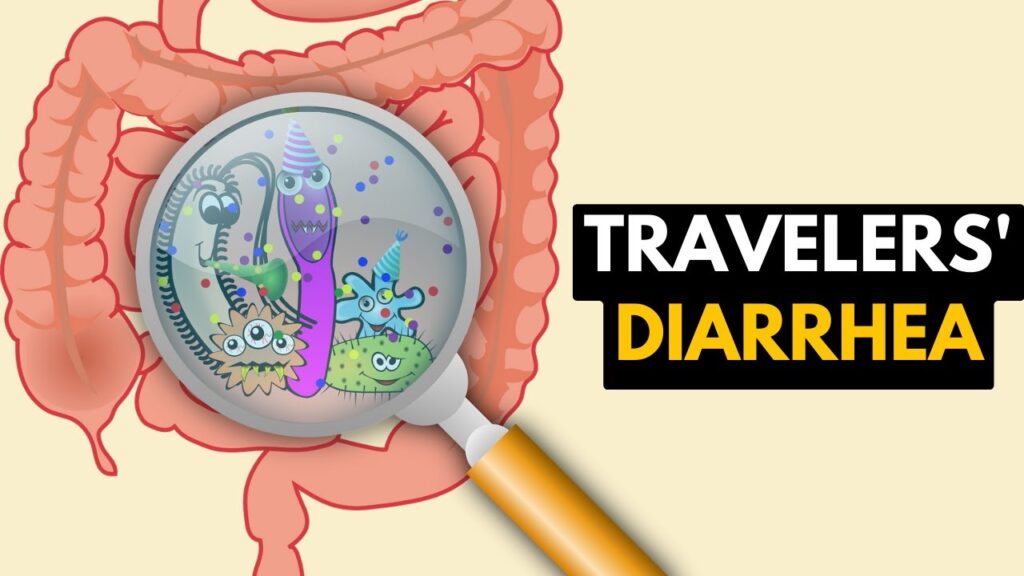Traveler’s diarrhea (TD) is the most common illness affecting international travelers, particularly those visiting low- and middle-income countries. It is typically caused by ingesting contaminated food or water and leads to acute gastrointestinal symptoms such as diarrhea, abdominal cramps, and sometimes fever and vomiting. While most cases are self-limiting, untreated severe episodes can result in dehydration and complications that disrupt travel plans.

Etiology and Pathogens Responsible for Traveler’s Diarrhea
Bacterial Causes
Approximately 80–90% of traveler’s diarrhea cases are bacterial. The most frequent causative agent is Enterotoxigenic Escherichia coli (ETEC). Other bacterial pathogens include:
- Enteroaggregative E. coli (EAEC)
- Enteroinvasive E. coli (EIEC)
- Shigella spp.
- Campylobacter jejuni
- Salmonella spp.
Viral and Parasitic Causes
- Viruses: Norovirus and rotavirus are less common but responsible for outbreaks, especially on cruise ships.
- Parasites: Giardia lamblia and Entamoeba histolytica are less common but may cause prolonged or recurrent diarrhea.
Symptoms of Traveler’s Diarrhea
Symptoms typically begin within 1 to 3 days of exposure and may last up to 3–5 days in uncomplicated cases.
- Frequent loose or watery stools (≥3 per day)
- Abdominal cramps or pain
- Urgency to defecate
- Nausea and vomiting
- Fever (mild to moderate)
- Malaise and dehydration
Symptoms are usually mild to moderate, but in 10–20% of cases, they may be severe enough to require medical intervention.
High-Risk Destinations for Traveler’s Diarrhea
Risk correlates with local sanitation standards and hygiene practices. Regions with the highest risk include:
- South Asia (India, Nepal, Bangladesh)
- Southeast Asia (Thailand, Indonesia)
- Sub-Saharan Africa
- Central America and Mexico
- Parts of South America (Peru, Bolivia)
Travelers visiting these regions should exercise increased caution with food and water consumption.
Risk Factors Contributing to Infection
- Consumption of untreated water
- Eating raw or undercooked food
- Street food consumption in unsanitary environments
- Poor hand hygiene
- Young age or elderly
- Underlying gastrointestinal conditions (e.g., IBS)
- Use of acid-reducing medications (PPIs, H2 blockers)
Preventive Measures for Traveler’s Diarrhea
Safe Eating and Drinking Practices
- Boil it, peel it, cook it, or forget it: Avoid raw produce unless peeled.
- Drink only bottled or treated water
- Avoid ice in beverages unless made from purified water
- Use bottled water for brushing teeth
- Eat food served piping hot
- Avoid buffet-style dining in high-risk areas
Hand Hygiene
- Wash hands frequently with soap and clean water
- Use alcohol-based hand sanitizers (≥60% alcohol) when soap is unavailable
Vaccination and Chemoprophylaxis
- Dukoral: Oral vaccine against cholera and ETEC—modest efficacy in high-risk travelers
- Bismuth subsalicylate (Pepto-Bismol): Preventive use in select cases, taken multiple times daily
- Antibiotic prophylaxis (e.g., rifaximin) is not routinely recommended but may be considered for high-risk individuals with immunosuppression or chronic illness
Diagnosis of Traveler’s Diarrhea
Routine diagnostic tests are often unnecessary unless:
- Symptoms persist beyond 14 days
- Severe dehydration or systemic infection is suspected
- Presence of blood or mucus in stool
- High fever
In such cases, the following may be ordered:
- Stool culture
- PCR-based multiplex assays
- Ova and parasite (O&P) examination
Treatment of Traveler’s Diarrhea
Rehydration
The primary treatment is fluid and electrolyte replacement:
- Oral Rehydration Salts (ORS): WHO-approved solutions help prevent dehydration
- Clear liquids: Broth, fruit juices (avoid caffeine and alcohol)
Antimicrobial Therapy
Prescribed based on severity and region of travel:
| Region | First-Line Antibiotic | Alternatives |
|---|---|---|
| South Asia | Azithromycin | Rifaximin (mild), Ciprofloxacin |
| Latin America | Ciprofloxacin | Azithromycin |
| Africa | Azithromycin | Rifaximin |
- Azithromycin: 500 mg once daily for 1–3 days
- Rifaximin: 200 mg three times daily for 3 days
- Ciprofloxacin: 500 mg twice daily for 1–3 days (check for resistance)
Antimotility Agents
- Loperamide: Reduces stool frequency; safe for use in adults without fever or bloody stools
- Should not be used if dysentery is suspected
When to Seek Medical Attention
Immediate medical evaluation is warranted if:
- Diarrhea persists beyond 72 hours
- High fever (>102°F)
- Presence of blood or mucus in stools
- Signs of severe dehydration (dry mouth, reduced urination, confusion)
- Travelers with chronic illnesses or immunosuppression
Complications of Traveler’s Diarrhea
Though often self-limiting, complications can occur in vulnerable individuals:
- Severe dehydration and electrolyte imbalance
- Post-infectious irritable bowel syndrome (PI-IBS)
- Reactive arthritis
- Prolonged diarrhea due to parasitic infections
Traveler’s Diarrhea in Special Populations
Children
- Higher risk of dehydration
- Prefer ORS and zinc supplementation
- Avoid antimotility agents
Pregnant Women
- Focus on hydration and safe dietary practices
- Avoid most antimicrobials unless prescribed
Immunocompromised Travelers
- Proactive preventive care and early treatment
- Higher likelihood of severe complications
Traveler’s diarrhea remains a critical issue in global travel medicine, with millions of cases annually. While modern antibiotics and rehydration therapies offer rapid relief, prevention remains the cornerstone. Ongoing research into vaccines and antimicrobial resistance will further shape clinical management.
Public awareness, pre-travel consultations, and strict hygiene practices are essential in reducing the burden of this preventable illness.